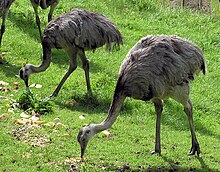| Rheas Temporal range: Pleistocene-Holocene
| |
|---|---|

| |
| Two greater rheas | |
| Scientific classification | |
| Domain: | Eukaryota |
| Kingdom: | Animalia |
| Phylum: | Chordata |
| Class: | Aves |
| Infraclass: | Palaeognathae |
| Order: | Rheiformes |
| Family: | Rheidae |
| Genus: | Rhea Brisson, 1760 |
| Type species | |
| Struthio americanus | |
| Species | |
| |
| Synonyms | |
| |
Rheas (/ˈriːəz/ REE-əz), also known as ñandus[a] (/njænˈduːz/ nyan-DOOZ) or South American ostrich,[1][2] are moderately sized South American ratites (flightless birds without a keel on their sternum bone) of the order Rheiformes. They are distantly related to the African ostriches and Australia's emu (the largest and second-largest living ratites, respectively), with rheas placing just behind the emu in height and overall size.
Most taxonomic authorities recognize two extant species: the greater or American rhea (Rhea americana), and the lesser or Darwin's rhea (Rhea pennata). The International Union for Conservation of Nature (IUCN) classifies the puna rhea as another species instead of a subspecies of the lesser rhea. The IUCN currently rates the greater and puna rheas as near-threatened in their native ranges, while Darwin's rhea is of least concern, having recovered from past threats to its survival. In addition, the feral population of the greater rhea in Germany appears to be growing. However, control efforts are underway and seem to succeed in controlling the birds' population growth. Similarly to ostriches and emus, rheas are fairly popular livestock and pets, regularly kept and bred on farms, ranches, private parks, and by aviculturists, mainly in North and South America and Europe.
Cite error: There are <ref group=lower-alpha> tags or {{efn}} templates on this page, but the references will not show without a {{reflist|group=lower-alpha}} template or {{notelist}} template (see the help page).
- ^ "nandu". The Chambers Dictionary (9th ed.). Chambers. 2003. ISBN 0-550-10105-5.
- ^ "rhea". Collins English Dictionary (13th ed.). HarperCollins. 2018. ISBN 978-0-008-28437-4.